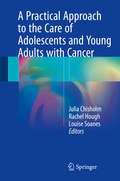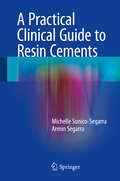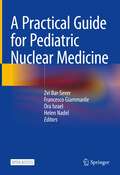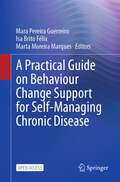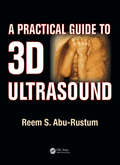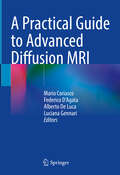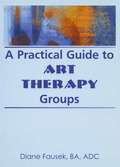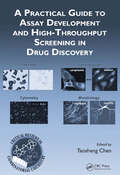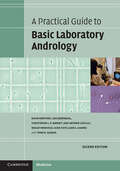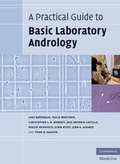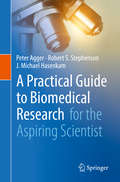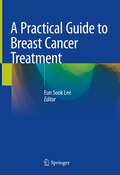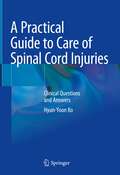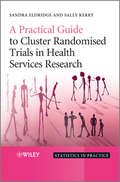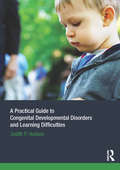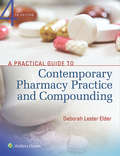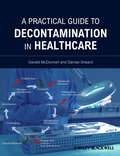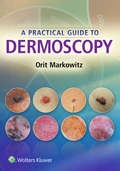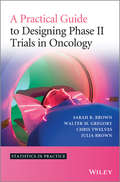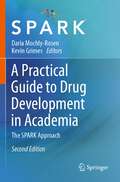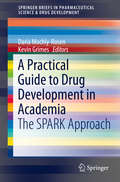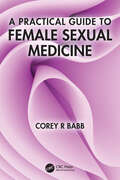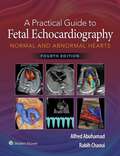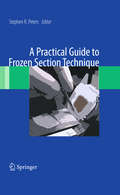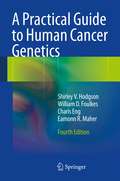- Table View
- List View
A Practical Approach to the Care of Adolescents and Young Adults with Cancer
by Julia Chisholm Rachael Hough Louise SoanesThis book discusses the most important practical aspects involved in providing multidisciplinary Adolescent and Young Adult (AYA) services for cancer patients. It draws on international experience in several continents of establishing and running such services and provides a contemporary, practical approach to AYA care based on accumulated experience. It is of interest to those establishing or seeking to improve AYA services as well as those already caring for AYA cance patients.Among topics discussed are incidence trends and treatment pathways, access to clinical trials for adolescents, transition from pediatric to adult services, psychological support and social care as well as survivorship and fertility.This book is of value of those establishing new services, those developing an existing service and those whose work includes the care of AYA patients. It is an important companion for pediatricians, oncologists as well as other medical, nursing and allied health professionals caring for Adolescents and Yound Adults with cancer.
A Practical Clinical Guide to Resin Cements
by Michelle Sunico-Segarra Armin SegarraThis book discusses and describes in detail the available resin cements, which are now a staple of dental practice. Factors that affect the clinical performance of resin cements are thoroughly examined and the different resin cements currently on the market are discussed in depth, with information on indications, limitations, handling and manipulation and storage. Decision trees and concept maps are provided to aid the clinician in choosing the right cement for particular clinical situations. The final part of the book is devoted to actual clinical procedures and provides step-by-step guidance on the cementation of inlays/onlays, veneers and crowns and bridges made of different materials. Frequently asked questions are also highlighted, with straight to the point answers. A Practical Clinical Guide to Resin Cements will serve as an invaluable reference that is ideal for consultation by clinicians prior to an important cementation procedure.
A Practical Guide for Pediatric Nuclear Medicine
by Ora Israel Zvi Bar-Sever Francesco Giammarile Helen NadelThis open access book will provide a foundation for the understanding of, and knowledge for a successful routine use of diagnostic Nuclear Medicine procedures in children through expertise and cases provided by representative busy pediatric nuclear medicine facilities. The book highlights important aspects of nuclear medicine in children and the differences between adult and pediatric practice where relevant.An introductory chapter provides general information detailing the advantages and limitations for performing nuclear medicine tests in children, as well as suggestions on how to approach and provide relevant data to the patients, their parents or next of kin. In the remaining 11 chapters, containing over 115 cases of children evaluated for various clinical indications, procedures are presented and subsequently detailed according to their clinical significance or prevalence based on the clinical experience of the contributors. The book is organized by organ systems, and also includes chapter on oncology and infection/ inflammation. Chapters are formatted to provide information regarding clinical indications, preparation including radiopharmaceutical doses and additional medications, study protocol, study interpretation, correlative imaging. Each chapter will include red flags warning and take home messages sections to emphasize important points. The case format is presented with patient history and then study report and impression.Based on practices explored by experts at the forefront of this field, the publication is directed at Nuclear Medicine physicians, radiologists, oncologists and clinicians in various pediatric specialties, medical physicists, medical technologists, radiopharmacists, laboratory medicine scientists and researchers.
A Practical Guide on Behaviour Change Support for Self-Managing Chronic Disease
by Mara Pereira Guerreiro Isa Brito Félix Marta Moreira MarquesThis open access book is a valuable resource for students in health and other professions and practicing professionals interested in supporting effective change in self-management behaviors in chronic disease, such as medication taking, physical activity and healthy eating.Developed under the auspices of the Train4Health project, funded by the Erasmus+ program of the European Union, the book contains six chapters written by international contributors from different disciplines. Chapter one introduces the competencies necessary for delivering effective behavior change support, based on an established program of work, and related learning outcomes. The four following chapters describe how these competencies can be acquired, focusing on concepts and theories, assessing self-management behaviors, implementing change strategies and person-centered communication, using a practical approach. The last chapter points out supplementary learning resources, developed as part of the Train4Health project.
A Practical Guide to 3D Ultrasound
by Reem S. Abu-RustumA Practical Guide to 3D Ultrasound was conceived with the beginner in mind. The guide summarizes the basics of 3D sonography in a concise manner and serves as a practical reference for daily practice. It is written in easy-to-read language and contains tables summarizing the step-by-step instructions for the techniques presented. Following introduc
A Practical Guide to Advanced Diffusion MRI
by Mario Coriasco Federico D'Agata Alberto De Luca Luciana GennariThis practical handbook on Diffusion Weighted MRI techniques provides a concise and schematic overview of several key aspects of this imaging modality. It covers the workflow from image acquisition to data processing, and provides context and examples of its application for imaging the brain and other body districts. The practical aspects of diffusion MRI, key mathematical principles and derived metrics underlying diffusion tensor imaging (DTI) are explored in depth, illustrating some advanced methods to overcome the limitations of DTI itself. This manual also names some of the main software tools available at the time of writing for processing, and provides step-by-step explanations of the main processing steps with examples to enhance understanding of the post-processing data workflow. This manual is intended for imaging professionals, including MR technologists and radiologists in training, as well as other professionals who routinely use MRI.
A Practical Guide to Art Therapy Groups
by Diane SteinbachAre you in need of some variety and imagination for your art therapy repertoire? If so, this is the book for you! Diane Fausek&’s unique approaches, materials, and advice will inspire you to tap into your own well of creativity to design your own treatment plans. A Practical Guide to Art Therapy Groups lays out the ingredients and the step-by-step plans, but it&’s up to you to mix in your own caring and therapeutic skills to get the results you want.A Practical Guide to Art Therapy Groups is the only book of its kind. It gives you not only fresh ideas, but also specific directions on topic and material implementation. With the book&’s specific guidelines and practical advice, you will find planning therapeutic group sessions easier and less time-consuming. When struggling for ideas, you can turn to this book as a source for many appealing themes and issues, already organized and grouped together with compatible materials for your convenience. You will learn how to: interweave fabric techniques and collage with personal philosophies and challenges enhance sensory stimulation through collage use painting techniques to improve abstract thinking skills and the ability to find images develop collage techniques using both traditional and nontraditional materials employ nature objects that emphasize clients’own natural flaws and strengths use stencils and the individual&’s silhouette to focus thoughts and energies at self-definition and group dynamicsWithin this book, you&’ll find many successful treatment plans that have been used in long-term care settings with clients affected by Alzheimer&’s, stroke complications, geri-psychiatric conditions, and developmental disabilities. Each plan can be adapted to fit your particular setting and the needs of your clients. Whether you are a student, a counselor, an art therapist, or an activity director, A Practical Guide to Art Therapy Groups can help you provide innovative, fun, and therapeutic opportunities for your clients and open the doors to communication.
A Practical Guide to Assay Development and High-Throughput Screening in Drug Discovery
by Taosheng ChenThe development of suitable assays, the integration of appropriate technology, and the effective management of the essential infrastructure are all critical to the success of any high-throughput screening (HTS) endeavor. However, few scientists have the multidisciplinary experience needed to control all aspects of an HTS drug discovery project. A P
A Practical Guide to Basic Laboratory Andrology
by Lars Björndahl David Mortimer Roelof Menkveld Ulrik Kvist Juan G. Alvarez Trine B. Haugen Christopher L. Barratt José Antonio CastillaThis practical, extensively illustrated handbook covers the procedures that are undertaken in andrology and ART laboratories to analyse and assess male-factor infertility, and to prepare spermatozoa for use in assisted conception therapy. The content is presented as brief, authoritative overviews of the relevant biological background for each area, plus detailed, step-by-step descriptions of the relevant analytical procedures. Each technical section includes quality control considerations and the optimum presentation of results. In addition to the comprehensive 'basic' semen analysis, incorporating careful analysis of sperm morphology, the handbook provides established techniques for the use of computer-aided sperm analysis and sperm functional assessment. The interpretation of laboratory results in the clinical context is highlighted throughout, and safe laboratory practice is emphasized. Fully revised, incorporating the new ISO TS 23162 on basic human semen analysis throughout, this is an invaluable resource to all scientists and technicians who perform diagnostic testing for male-factor infertility.
A Practical Guide to Basic Laboratory Andrology
by Lars Björndahl David Mortimer Jose Antonio Castilla Roelof Menkveld Ulrik Kvist Juan G. Alvarez Trine B. Haugen Christopher L. R. BarrattThis practical, extensively illustrated handbook covers the procedures that are undertaken in andrology and ART laboratories to analyse and assess male-factor infertility, and to prepare spermatozoa for use in assisted conception therapy. The content is presented as brief, authoritative overviews of the relevant biological background for each area, plus detailed, step-by-step descriptions of the relevant analytical procedures. Each technical section includes pertinent quality control considerations, as well as the optimum presentation of results. In addition to the comprehensive 'basic' semen analysis, incorporating careful analysis of sperm morphology, the handbook provides established techniques for the use of computer-aided sperm analysis and sperm functional assessment. Throughout the handbook the interpretation of laboratory results in the clinical context is highlighted, and safe laboratory practice is emphasized. It is an invaluable resource to all scientists and technicians who perform diagnostic testing for male-factor infertility.
A Practical Guide to Biomedical Research
by Peter Agger Robert S. Stephenson J. Michael HasenkamThis book advises and supports novice researchers in taking their first steps into the world of scientific research. Through practical tips and tricks presented in a clear, concise and step-wise manner, the book describes the entire research process from idea to publication. It also gives the reader insight into the vast opportunities a research career can provide. The books target demographic is aspiring researchers within the biomedical professions, be it medical students, young doctors, nurses, engineers, physiotherapists etc. The book will help aspirational inexperienced researchers turn their intentions into actions, providing crucial guidance for successful entry into the field of biomedical research.
A Practical Guide to Breast Cancer Treatment
by Eun Sook LeeThis book presents expert viewpoints on the diverse situations faced by practitioners in their daily practice when caring for patients with breast cancer, with focuses on the patient-centered treatment process. It provides the entire process of different patient cases from patient history, radiologic examination, pathologic results, surgical outcome and medical treatment.The aim is to equip readers with all the knowledge required in order to implement appropriate case-by-case approaches in the real world, where circumstances frequently differ from the typical or straightforward scenarios depicted in textbooks and articles.The book will serve as a practice guideline for novices less familiar with the field, but it will also be a valuable aid for more experienced practitioners and will even offer assistance in research planning. Furthermore, the book will help some patient to infer their own treatment by using similar cases as a model.
A Practical Guide to Care of Spinal Cord Injuries: Clinical Questions and Answers
by Hyun-Yoon KoThis book, structured as a collection of questions and answers commonly encountered in the care of individuals with spinal cord injuries, aims to facilitate easy access to clinical and practical information for those involved in their treatment. The author, known for their expertise in spinal cord injuries, has developed this book to offer concise knowledge specifically tailored for clinicians and related healthcare professionals engaged in the care of spinal cord injuries. Unlike his previous works, this book goes beyond the traditional format and incorporates more concise and clinically-oriented questions and answers. Drawing from the author's practical experience and his role in training resident physicians in spinal cord medicine at the University Hospital, the content of this book addresses practical and clinical considerations. To enhance clinical understanding, the book extensively employs figures and tables throughout its comprehensive coverage of various aspects of spinal cord medicine. The author aspires for this book to serve as a valuable clinical companion, providing supplemental practical guidance for daily practice in the field of spinal cord injuries.
A Practical Guide to Cluster Randomised Trials in Health Services Research
by Sandra Eldridge Sally KerryCluster randomised trials are trials in which groups (or clusters) of individuals are randomly allocated to different forms of treatment. In health care, these trials often compare different ways of managing a disease or promoting healthy living, in contrast to conventional randomised trials which randomise individuals to different treatments, classically comparing new drugs with a placebo. They are increasingly common in health services research. This book addresses the statistical, practical, and ethical issues arising from allocating groups of individuals, or clusters, to different interventions. Key features: Guides readers through the stages of conducting a trial, from recruitment to reporting.Presents a wide range of examples with particular emphasis on trials in health services research and primary care, with both principles and techniques explained.Topics are specifically presented in the order in which investigators think about issues when they are designing a trial.Combines information on the latest developments in the field together with a practical guide to the design and implementation of cluster randomised trials.Explains principles and techniques through numerous examples including many from the authors own experience.Includes a wide range of references for those who wish to read further. This book is intended as a practical guide, written for researchers from the health professions including doctors, psychologists, and allied health professionals, as well as statisticians involved in the design, execution, analysis and reporting of cluster randomised trials. Those with a more general interest will find the plentiful examples illuminating.
A Practical Guide to Congenital Developmental Disorders and Learning Difficulties
by Judith P. HudsonTo give children with congenital developmental conditions that manifest special learning needs and specific disabilities their best chance to succeed, early identification and appropriate interventions and support, is necessary. This text highlights what to look for when there are concerns about a child’s development. Practical and accessible, it is divided into three sections: Part 1 looks at the theory and policy context, discussing the social model of disability, the responsibility of health, social care and education services to the child and family and the role of reviews and assessment in recognising developmental disorders. Part 2 provides a reference guide to atypical developmental conditions and disorders. For each condition, aetiology, prominent theories and research, profile of features – including triggers and behaviours, diagnostic assessment procedures and appropriate interventions are given and links made to sources of further information and support. Part 3 explores practical issues how to work sensitively and effectively with children and their families, looking at the psychological implications of diagnosis, and how to plan, promote, deliver and evaluate multi-agency support. Designed to support professionals working within a multi-modal, collaborative approach to assessment and intervention processes, it is suitable for health visitors, allied health therapists, nurses, teachers and social care practitioners. It is also a useful reference for students in these areas learning about child development and includes critical reading exercises; online searching tasks; self-assessment questions; reflective activities and document analysis prompts.
A Practical Guide to Contemporary Pharmacy Practice and Compounding
by Deborah LesterA Practical Guide to Contemporary Pharmacy Practice and Compounding is your hands-on, step-by-step guide to receiving and filling prescription drug orders as well as a comprehensive look at the preparation of sterile and non-sterile extemporaneously compounded preparations.
A Practical Guide to Decontamination in Healthcare
by Gerald Mcdonnell Denise Sheard Diploma NursingPrevention is the first line of defence in the fight against infection. As antibiotics and other antimicrobials encounter increasing reports of microbial resistance, the field of decontamination science is undergoing a major revival. A Practical Guide to Decontamination in Healthcare is a comprehensive training manual, providing practical guidance on all aspects of decontamination including: microbiology and infection control; regulations and standards; containment, transportation, handling, cleaning, disinfection and sterilization of patient used devices; surgical instrumentation; endoscopes; and quality management systems. Written by highly experienced professionals, A Practical Guide to Decontaminationin Healthcare comprises a systematic review of decontamination methods, with uses and advantages outlined for each. Up-to-date regulations, standards and guidelines are incorporated throughout, to better equip healthcare professionals with the information they need to meet the technical and operational challenges of medical decontamination. A Practical Guide to Decontaminationin Healthcare is an important new volume on state-of-the-art decontamination processes and a key reference source for all healthcare professionals working in infectious diseases, infection control/prevention and decontamination services.
A Practical Guide to Dermoscopy
by Orit MarkowitzDermoscopy has revolutionized the evaluation of pigmented lesions, but pattern recognition alone isn’t always sufficient to make a diagnosis. A Practical Guide to Dermoscopy helps you use Dr. Orit Markowitz’s unique, “color wheel” approach to solve difficult diagnostic challenges, particularly when it comes to distinguishing between malignant and benign conditions, and thus expedite effective treatment.
A Practical Guide to Designing Phase II Trials in Oncology
by Christopher J. Twelves Walter M. Gregory Sarah R. Brown Julia M. BrownA comprehensive and practical overview of the identification, conduct and analysis of optimal Phase II trial design. Choosing Your Phase II Trial Design demonstrates how to approach trial design when there are various options available, such as multiple possible outcome measures, and to use the key characteristics provided to make an informed decision regarding which specific trial design to choose. It sets forth specific points for consideration between the statistician and clinician when designing a phase II trial, including issues such as how the treatment works, choice of outcome measure and randomization. Real life examples and case studies featured throughout the book are accompanied by illustrations using a flow diagram, highlighting the choices made for each key point throughout the process.Choosing Your Phase II Trial Design provides an introduction to key concepts for beginners and explores lesser known and alternative approaches to trial design for the more experienced researcher.
A Practical Guide to Drug Development in Academia: The SPARK Approach
by Daria Mochly-Rosen Kevin Grimes"A lot of hard-won knowledge is laid out here in a brief but informative way. Every topic is well referenced, with citations from both the primary literature and relevant resources from the internet." Review of first edition from Nature Chemical BiologyWritten by the founders of the SPARK program at Stanford University, this book is a practical guide designed for professors, students and clinicians at academic research institutions who are interested in learning more about the drug development process and how to start transforming their basic research discoveries into novel drugs. Often many potentially transformative basic science discoveries are not pursued because they are deemed ‘too early’ to attract industry interest. This comprehensive book lays out simple, relatively cost-effective things that academic researchers can do to advance their findings to the point that they can be tested in the clinic or attract more industry interest.Each chapter broadly discusses an important topic in drug development, from discovery, optimization and preclinical studies through clinical trial design, regulatory issues and marketing assessments. After the practical overview provided here, the reader is encouraged to consult more detailed texts on specific topics of interest.The SPARK model has been adopted in over 60 institutions on six continents, and the program has been honored with multiple awards including the 2020 Xconomy Award for Ecosystem Development, the 2020 Cures Within Reach Award for Patient Impact Research, and the 2022 California Life Sciences Pantheon Award for Academia, Non-Profits, & Research.The new edition updates every chapter with the latest developments since the 2014 publication of the first edition.
A Practical Guide to Drug Development in Academia: The SPARK Approach (SpringerBriefs in Pharmaceutical Science & Drug Development)
by Daria Mochly-Rosen Kevin Grimes"A lot of hard-won knowledge is laid out here in a brief but informative way. Every topic is well referenced, with citations from both the primary literature and relevant resources from the internet. " Review from Nature Chemical Biology Written by the founders of the SPARK program at Stanford University, this book is a practical guide designed for professors, students and clinicians at academic research institutions who are interested in learning more about the drug development process and how to help their discoveries become the novel drugs of the future. Often many potentially transformative basic science discoveries are not pursued because they are deemed 'too early' to attract industry interest. There are simple, relatively cost-effective things that academic researchers can do to advance their findings to the point that they can be tested in the clinic or attract more industry interest. Each chapter broadly discusses an important topic in drug development, from preclinical work in assay design through clinical trial design, regulatory issues and marketing assessments. After the practical overview provided here, the reader is encouraged to consult more detailed texts on specific topics of interest. "I would actually welcome it if this book's intended audience were broadened even more. Younger scientists starting out in the drug industry would benefit from reading it and getting some early exposure to parts of the process that they'll eventually have to understand. Journalists covering the industry (especially the small startup companies) will find this book a good reality check for many an over-hopeful press release. Even advanced investors who might want to know what really happens in the labs will find information here that might otherwise be difficult to track down in such a concentrated form. "
A Practical Guide to Female Sexual Medicine
by Corey R BabbThe appropriate diagnosis, management, and even terminology for women with sexual health problems have all been much debated in the past few years. This practical text aims to guide the gynecologists, urologists, family physicians, and other professionals involved with the care of these patients. With case presentations, treatment algorithms, and schematic illustrations, this comprehensive yet accessible text will be an invaluable reference for the current state of the clinical art. Provides an accessible guide to a very contested area of patient care Offers a comprehensive resource for the gynecologists, urologists, and family physicians involved in care for patients with female sexual dysfunction Presents a concise and practical route through the clinical details a professional physician needs for patient diagnosis and management
A Practical Guide to Fetal Echocardiography: Normal and Abnormal Hearts
by Rabih Chaoui Alfred AbuhamadCovering every aspect of fetal heart examination and all major cardiac malformations, A Practical Guide to Fetal Echocardiography is widely acknowledged as the definitive text in this challenging field. This award-winning title clearly depicts examples of commonly seen abnormalities and day-to-day cases, as well as rare pathology. Authored by renowned experts, the fully updated fourth edition is a lavishly illustrated, easy-to-read text designed to serve as a comprehensive reference for all practitioners involved in cardiac imaging.
A Practical Guide to Frozen Section Technique
by Stephen R. PetersA Practical Guide to Frozen Section Technique offers an easy to learn approach to frozen section technique in the form of a highly illustrated handbook intended for onsite use in the laboratory. The book begins with a novel, clearly delineated, step by step approach to learning continuous motion brush technique. Emphasis is placed on recognizing and correcting artifacts during the preparation process. The book addresses all of the steps in the preparation of slides from cutting through cover-slipping. The author's unique, original techniques for tissue embedding including face down embedding in steel well bars, frozen block cryoembedding and paper cryoembedding are detailed. Variables key to the quality of the preparation including block temperature, tissue properties and section thickness are detailed. The book also covers understanding the cryostat and basic maintenance and care.Sections covering techniques used in Mohs dermatologic surgery, and techniques used in basic animal and human research are discussed by noted experts in their field. A Practical Guide to Frozen Section Technique will be of great value to pathologists, pathology residents in training and also experimental pathology researchers that rely upon this methodology to perform tissue analysis in research.
A Practical Guide to Human Cancer Genetics
by William D. Foulkes Shirley V. Hodgson Charis Eng Eamonn R. MaherThis is a comprehensive and up-to-date guide to the diagnosis, clinical features and management of inherited disorders conferring cancer susceptibility. It is fully updated with much molecular, screening and management information. It covers risk analysis and genetic counselling for individuals with a family history of cancer. It also discusses predictive testing and the organisation of the cancer genetics service. There is information about the genes causing Mendelian cancer predisposing conditions and their mechanism of action. It aims to provide such details in a practical format for geneticists and clinicians in all disciplines.
